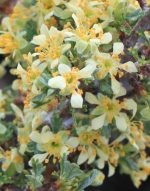 Also known as bitterbrush, buckbrush, and quinine brush this semi-evergreen shrub is native to open woods, stream banks, rocky slopes and pine forest in mountainous areas from Alberta to British Columbia, south to New Mexico and California. It belong to the rose family, Roasaceae, that also includes cherry, lady’s mantel and Pyracantha. The plant has a long tap root and many stiff erect branches that carry small oval leathery leaves ¼-3/4 inch long that are green to gray-green above and grayish-white beneath. They have three lobes and inward rolled margins during times of extremely hot weather when they also emit a resinous smell . The pale yellow flower and have five flared petals and long dark yellow anthers that protrude beyond the corolla. The flowers are short lived but borne singly from spring to early summer. Plants are nitrogen fixing and very drought and heat tolerant but do best where nights are cool. They are a good choice for a hedge, screen, shelterbelt, mass or informal planting, erosion control, and revegetation on disturbed sites. The genus name, Purshia, refers to the German-American botanist, F.T. Pursh, who originally described the plant. The specific epithet, tridentate, comes from the Latin words tres meaning three and dens, meaning teeth, and refers to the three teeth at the end of the leaf. The common name, antelope brush, suggests the importance of the plant as a browse species for antelopes.
Also known as bitterbrush, buckbrush, and quinine brush this semi-evergreen shrub is native to open woods, stream banks, rocky slopes and pine forest in mountainous areas from Alberta to British Columbia, south to New Mexico and California. It belong to the rose family, Roasaceae, that also includes cherry, lady’s mantel and Pyracantha. The plant has a long tap root and many stiff erect branches that carry small oval leathery leaves ¼-3/4 inch long that are green to gray-green above and grayish-white beneath. They have three lobes and inward rolled margins during times of extremely hot weather when they also emit a resinous smell . The pale yellow flower and have five flared petals and long dark yellow anthers that protrude beyond the corolla. The flowers are short lived but borne singly from spring to early summer. Plants are nitrogen fixing and very drought and heat tolerant but do best where nights are cool. They are a good choice for a hedge, screen, shelterbelt, mass or informal planting, erosion control, and revegetation on disturbed sites. The genus name, Purshia, refers to the German-American botanist, F.T. Pursh, who originally described the plant. The specific epithet, tridentate, comes from the Latin words tres meaning three and dens, meaning teeth, and refers to the three teeth at the end of the leaf. The common name, antelope brush, suggests the importance of the plant as a browse species for antelopes.
Type: Semi-deciduous shrub
Outstanding Features: Heat and drought tolerance; flowers
Form: Rounded to oval and mounding
Growth Rate: Slow
Bloom: Pale yellow flower with five flared petals and long dark yellow anthers protruding beyond the corolla from spring to early summer
Size: 4-10’ H
Light: Full sun
Soil: Average, dry to medium moist, well drained, neutral to alkaline
Hardiness: Zones 4-9
Care: Low maintenance
Pests and Diseases: None of significance
Propagation: Seed with stratification, layering